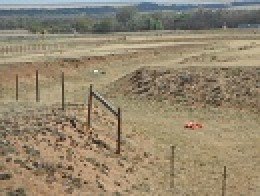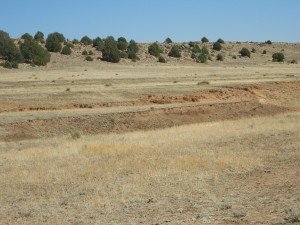Some of the most fascinating adobe ruins from the days of the old Santa Fe Trail can be found in northeastern New Mexico at the site of the former Fort Union, one of the most important and largest military outposts along the old Santa Fe Trail.
Thank you for reading this post, don't forget to subscribe!
Historic Fort Union
Fort Union played a major role during the old western trail days as well as during the American Civil War and for years after while New Mexico Territory was being settled. The spread out military post combined three sub-installations. The Ordinance Depot, the Quartermaster depot and the post.
The army occupied Fort Union until 1889. Many of the old frontier forts were closed down about that time with the ending of the Indian Wars all throughout the west. Fort Union today comprises about 100 acres of adobe ruins. Detailed maps are available for a self guided walking tour with markers detailing what each set of ruins represent. I think that the fact that Fort Union was not rebuilt like many of the other surviving western fort historic sites make a trip their much more unique. Also, because the National Park Service has researched and detailed the adobe ruins so extensively, the visitor is able to fully understand what he or she is observing. Again, it probably is the most unique old western fort site you can visit.

Fort Union National Monument
Today, Fort Union is a National Monument administered by the National Park Service. If your next southwestern road trip takes you along Interstate 25 between Colorado and New Mexico, this is a site you will want to visit.
The location is about 95 miles south of Raton New Mexico, 240 miles south of Colorado Springs Colorado and 95 miles north of Santa Fe. Take the Watrous exit 366 and drive west eight miles on NM Hwy 161. The adobe walled ruins have been stabilized which is absolutely necessary with all old genuine adobe. The job they have done with it is remarkable. Genuine adobe is usually a mixture of straw and mud and because of this it will deteriorate completely if not stabilized. The new adobe structures you see today in the southwest are actually not true adobe. At least not true adobe compared to what was constructed in the 19th century.
A Key Fort at an Important Crossroads
Fort Union was established in 1851 and remained in service until it’s closing in 1889. This span of years represented three distinct historical eras. The 1850’s were a time during the first decade of U.S. occupation of New Mexico Territory after the end of the Mexican American War.

The fort’s objectives were to guard the all important Santa Fe Trail trade route from Indian attack. The Cimarron Cut Off on the Santa Fe Trail runs northeast from the fort into Kansas and was roamed by the Comanches. The fort is also located near where the Cimarron Cut Off intersected with the Mountain Route of the trail which came down from the north in Colorado. Today, the old Santa Fe Trail Mountain Route which was used more heavily than the Cimarron was the approximated route of the old Atchison and Topeka & Santa Fe Railroad. The railroad came through in 1878-79 and is today the route of Amtrak’s Southwest Chief.
Fort Union was also the home of the Ninth Cavalry of the Buffalo Soldiers for five years from 1876 to 1881. Regiments of black soldiers actually served in many western forts on the Plains and in the southwest including several in Texas such as Fort Concho. The Buffalo Soldiers continued to protect the trail and saw a good deal of action but when the Atchison Topeka & Santa Fe Railroad came through the area in 1878 and 1879, the Santa Fe Trail started to diminish in importance. The trail continued to be used but the focal point became the railroad.

Santa Fe Trail Wagon Train Ruts
Old Santa Fe Trail wagon train ruts are clearly visible in and around Fort Union. The Mountain Route of the trail ran directly to Ft Union from the north. Maps show that the Cimarron trail route intersected about six miles southeast of the fort.
Being located at that junction meant that Fort Union also operated as a supply depot. Many of the wagon trains over the Santa Fe Trail were actually freight caravans. Some of the trail remnants are deep and other sections are barely visible, but they are visible. When you visit Ft Union, the staff will give you a Santa Fe Trail map that shows exactly where the wagon train ruts are located where they pass directly through the old fort. On your walking tour of the adobe ruins you’ll see the wagon trail marked with signs. One thing to remember is that the wagon trains traveled perhaps three abreast at times so the trail widens and narrows in various sections. Some sections are clearly visible and others take a bit more close inspection to be seen. The length of the trail remnants that remain are truly amazing considering the amount of years that have passed.
Two additional Trips Into History articles you’ll find interesting are The Frontier Soldier’s Life and the Army’s Mountain Howitzer.
A Decisive Civil War Battle
Ft Union New Mexico actually played a key role during the American Civil War. The southwest was invaded by Confederate forces comprised mostly of Texas volunteers. The infiltration into New Mexico Territory was mostly in the southern section of what is today the states of New Mexico and Arizona.

At one point an advance was made to the north. Albuquerque itself was occupied by the Confederates for a short time. Another Confederate advance led by General Henry Sibley was made northeastward toward the Santa Fe Trail just east of Santa Fe and very near Pecos New Mexico.
The job of the troops at Fort Union was to protect the Santa Fe Trail. During the years of the Civil War, this western trail had to be protected from both the Indians and the Confederates. As a result of General Sibley’s advance into northern New Mexico Territory, a force of Union regulars along with Colorado volunteers met the advancing Confederates at the famous Battle of Glorieta Pass. The battle was ultimately won by the Union forces and the Confederate defeat there signaled the end of their advancement northward.
I highly recommend a stop at the Fort Union National Monument for anyone traveling the section of Interstate 25 south of the Colorado border. While the fort is in a remote area of the state, the fact that it’s only eight miles off the Interstate makes it very accessible The National Monument provides a terrific display of old adobe architecture at a very historic site. Viewing the artifacts in the visitor center museum, the twenty minute video and the walking tour of the ruins really gives you a fine glimpse at what exactly took place during the days of the mid 1800’s while the army oversaw the safety of the Santa Fe Trail.
(Photos are from author’s private collection)
